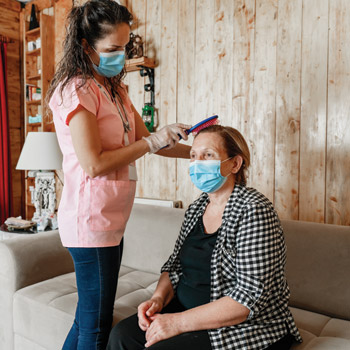Help elderly patients catch their zzz's
Sleep problems are common, but not inevitable, as people age.
There's a reason everyone wants to sleep like the proverbial baby.
“Sleep disruption is exceedingly common, reported by half of older adults,” said sleep expert Lauren Tobias, MD, while speaking at CHEST 2020, held online in October 2020.
Research has confirmed that aging is associated with worsening sleep. “Most studies have shown reductions in total sleep time, sleep efficiency, and slow-wave sleep, and increases in time spent awake after sleep onset, number of arousals, and sleep latency,” said Dr. Tobias, an assistant professor at Yale School of Medicine in New Haven, Conn., and medical director of the sleep program for the VA Connecticut Health System.
That doesn't mean these sleep problems are inevitable, however. “It's crucial that we avoid normalizing sleep disturbance, although many patients tend to do this themselves, assuming their symptoms are just part of getting older,” she said. “This decrease in total sleep time does not mean older adults need less sleep, rather that they may have impairments in their ability to achieve the same number of hours of sleep.”

Dr. Tobias and fellow sleep expert Sara Pasha, MD, offered advice on identification of sleep problems in older patients, including those with dementia, as well as potential interventions ranging from continuous positive airway pressure (CPAP) and medications to simple habit changes.
Finding the causes
Sleep problems in older patients can result from many factors, some as simple as lifestyle choices. “It's very common to see sleep problems resulting from behavioral factors such as the lack of a fixed work schedule or regular meal times in patients who are retired,” said Dr. Tobias.
On the flip side, some sleep problems may be partially alleviated by retirement, she noted. “Patients with circadian rhythm disorders may find it actually easier to function after retirement when they no longer need to conform to a regular work schedule and they can assume sleep times better aligned with their own biological rhythms.”
Other potential external causes include caregiving. “Their sleep may be fragmented by providing assistance to a spouse in the middle of the night. There are also environmental factors such as social isolation, or institutionalization, both of which can relate to reductions in sunlight exposure, an important stimulus for circadian stabilization,” said Dr. Tobias. Vision loss can also reduce exposure to natural light.
Being less active during the day commonly contributes, too. “As you can imagine, patients who spend more time sitting or in bed due to disability may be more prone to doze during the day, thereby disrupting their ability to fall or stay asleep at night,” she said.
Common medical problems hinder sleep in other ways: “nocturnal dyspnea in heart failure; pain from arthritis, which is so common in this population; psychiatric disorders; and medications that cause sleepiness,” she listed.
There are many potential medical and medication causes of sleep problems in the elderly, agreed Dr. Pasha, who is an assistant professor of medicine at the University of Kentucky (UK) and medical director of the UK Sleep Disorders Center in Lexington, Ken.
“In the elderly population, there might be comorbid medical disorders, comorbid mood disorders, circadian rhythm disorders, especially advanced sleep phase disorder, sleep-disordered breathing, restless legs,” said Dr. Pasha. Common medications that can cause sleep problems include antidepressants, antipsychotics, beta-blockers, anti-arrhythmics, and opioids, she said.
Nocturia is another cause older patients often cite for their sleep problems. “A third of older adults are bothered by symptomatic nocturia, defined as at least two episodes per night,” said Dr. Tobias. It would seem natural to look at the bladder as the cause of these symptoms, but that's not necessarily the culprit.
“It turns out it has nothing to do with bladder capacity, as that does not change with age,” she said. Instead, nocturia may be caused by hypoxemia due to sleep apnea, which leads to release of diuretic hormones that are suppressed during normal sleep. “Another potential mechanism is that patients are waking up from an arousal related to their underlying sleep apnea, as opposed to a full bladder per se, but now they're awake so they need to urinate,” she said.
This all supports the importance of careful evaluation of older patients with sleep problems, in whom the usual screening methods may be less effective, the experts said. For example, the Epworth Sleepiness Scale is not well validated in older adults, Dr. Tobias reported. “One study found that only a quarter of sleepy older adults had an Epworth that was in the abnormal range, over 10.”
Input from family members on issues such as sleep habits might be more critical to diagnosis than it is in younger patients. “I've had patients deny daytime napping, only to have their partner chime in that they're in fact observing them to doze off on the couch,” said Dr. Tobias. Older patients with sleep apnea are less likely than younger ones to have apnea or snoring witnessed by a partner, she noted.
Treatments
Treatment of a sleep problem, of course, will depend on its cause. If the issue is circadian, the fixes may be simple. “The behavioral and environmental strategy should be the beginning and the cornerstone,” said Dr. Pasha. “These include things like structured social activity, avoidance of daytime naps. Light therapy has been shown to help, though the timing, duration, and intensity is unknown.”
Also review patients' medications to see if changes can be made to lessen their impact on sleep. Whether to medicate sleep problems is a tougher call. “Pharmacologic interventions are commonly used, melatonin being one of them,” Dr. Pasha said. “Keep in mind the caveat that comes with melatonin is that it's classified as a supplement and so it comes without FDA regulation.”
As a result of the absence of regulation, a melatonin pill may contain a higher or lower dose than stated on the label, or even other substances. This limitation has also affected the validity of research on melatonin, she noted.
Benzodiazepines might help people sleep, but they might also increase sleep-disordered breathing, daytime sleepiness, and fall risk. “I would say that the use of benzodiazepines, which is common to treat circadian rhythm disorders in this group, should be done cautiously, or maybe not at all,” said Dr. Pasha.
If the cause of the problem is sleep apnea, then CPAP is the obvious treatment, yet it's not always the chosen one, according to Dr. Tobias. “I think many of us may have a sense of reluctance about starting this in older patients because it requires significant behavioral modification on the part of the patient,” she said.
Older patients have a number of particular barriers to CPAP use, including sleeping alone without a partner to support intervention, having less manual dexterity to use the machine, and having other comorbidities to handle. “Despite all these challenges, many early studies have found that adherence in older adults was actually similar to younger ones,” Dr. Tobias reported.
Research has also indicated that older patients accrue benefits from CPAP use. Randomized trials have shown that CPAP can improve quality of life and sleepiness in older patients, and sleep apnea has been associated with a number of negative outcomes in this population, including stroke. However, whether CPAP significantly reduces the risk of these outcomes is less clearly established in older patients, Dr. Tobias noted.
The choice of treatment should be based on the severity of sleep apnea and the patient's perspective, she added. “This involves an honest discussion with a patient, mutual decision making, about what we know about CPAP's benefits in that age group, what we don't know, and whether it's worth trying,” said Dr. Tobias. “Most of my patients do decide to pursue CPAP with close follow-up and of course re-evaluation of whether they feel they're getting benefit.”
Dementia and sleep
For patients with dementia, diagnosis and treatment of sleep problems can be even more complicated, but also more crucial.
“Sleep disruptions contribute to high caregiver burden. They are the leading cause of institutionalization of patients with dementia. Institutionalization comes with significant personal, societal, and economic costs and should be avoided or delayed as a much as possible,” said Dr. Pasha.
Dementia patients can have all the previously mentioned causes of sleep disturbance that are prevalent in their age group, as well as some others. “What is very specific to this group is excessive nocturnal motor activity,” she said.
That can take the form of REM sleep behavior disorder. “REM sleep behavior disorder is common to all the dementias,” Dr. Pasha said. Brain degeneration causes patients to lose the atonia that is normal during REM sleep, she explained.
“When that partial paralysis is not there, then you can see things as simple as simple movements to complex dream content enactment,” Dr. Pasha said. “Usually their dreams are violent, they're anxiety provoking, and so there's high potential for the patient to fall out of bed, to injure themselves, or injure their bed partners.”
She noted that these sleep problems can present as long as 10 years before the associated dementia does. “If a patient presents with symptoms that are consistent with REM sleep behavior disorder, a full history and neurological exam is mandated because you want to make sure you're not missing something, and obviously full disclosure to the patient is important,” she said. The disorder can be diagnosed clinically, but polysomnography should be ordered if there's uncertainty or suspicion about other causes.
Treatment options are environmental and pharmacological. “The treatment is to begin with environmental safeguards, making sure this person cannot leave the house, fall out of bed,” said Dr. Pasha. Patients should also try to improve sleep hygiene and avoid sleep deprivation, and clinicians should consider that antidepressants are known to worsen this disorder.
The next step is medications. “Traditionally, what's been done is low-dose [clonazepam], 0.25 to 1 mg at bedtime,” she said. Melatonin has also been used, Dr. Pasha said, but she warned clinicians to consider the previously mentioned caveats on use of either of these drug classes.
In some cases, a patient's sleep problem might be specific to the dementia-causing disease, for example, Parkinson's disease. “They may be unable to turn themselves at night when their bradykinesia sets in, and so making sure that they are on long-acting formulation of their dopamine agonists can help in that subgroup,” she noted.
In general, though, the causes of sleep problems in dementia patients are usually horses, not zebras. “What about sleep disorders that are so esoteric, things that are specific to certain degenerative disorders?” asked Dr. Pasha. “It's good to know that actually there aren't that many.”
One exception is multiple system atrophy, previously known as Shy-Drager syndrome. “Because of the involvement of respiratory parts of the brain during this disorder, it is particularly associated with sleep-disordered breathing,” she said.
Patients may present with nocturnal stridor, which can cause death. “So it's very important to ask for that history,” said Dr. Pasha. “CPAP is the first line of therapy, but there has to be mandatory compliance, and in emergency situations, tracheostomy might be the only thing. … Unfortunately, the development of nocturnal stridor in this patient population is a very poor prognostic sign.”
In most situations, though, treatment for sleep problems can effectively improve life for patients with dementia and their families. “Consider all avenues of improving sleep both for the patient and for the caregiver, a holistic approach which involves evaluation for common sleep complaints in the elderly … and as much as possible avoidance of polypharmacy and recognition that other comorbid medical disorders and mood disorders can exacerbate sleep disorders in this population,” she concluded.




